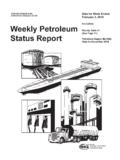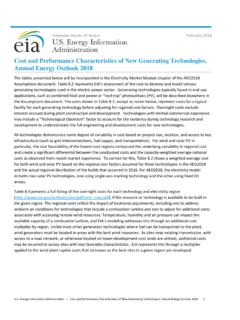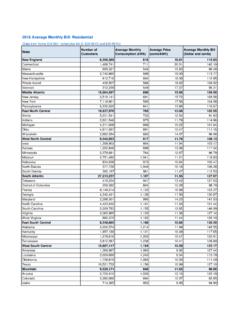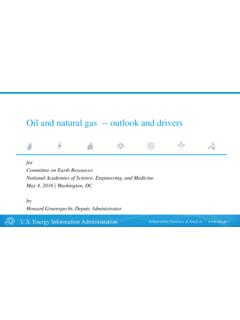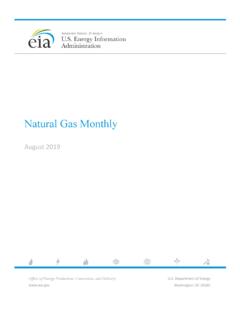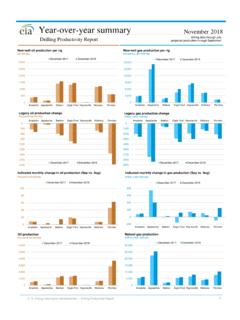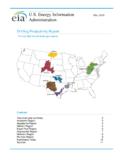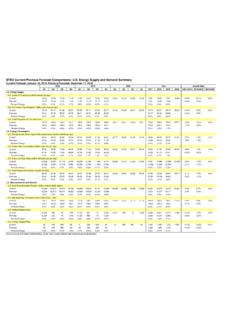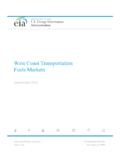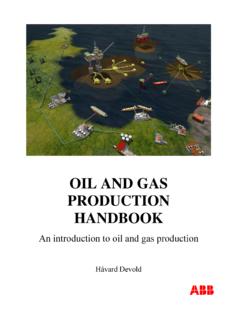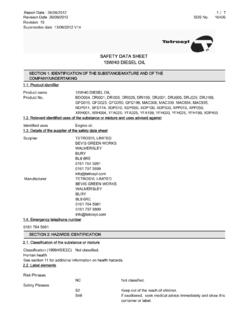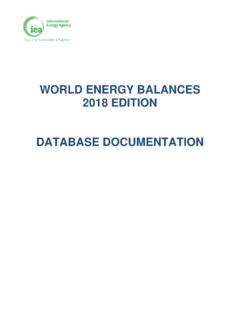Transcription of Country Analysis Executive Summary: Russia
1 1 Country Analysis Executive Summary: Russia Last Updated: December 13, 2021 Overview Russia was the world s third-largest producer of petroleum and other liquids (after the United States and Saudi Arabia) in 2020; it had an annual average of million barrels per day (b/d) in total liquid fuels production. Russia was the second-largest producer of dry natural gas in 2020 (second to the United States), producing an estimated trillion cubic feet (Tcf). Europe is Russia s main market for its oil and natural gas exports, and by extension, Europe is its main source for revenues. Russia is a major source of oil and natural gas for Europe; a significant share of Europe s oil and natural gas imports come from Russia . Since 2014, Russia has been subject to sanctions imposed by the United States and the European Union (EU). The sanctions were imposed in response to the actions and policies of the Russian government with respect to Ukraine.
2 The sanctions mainly affect Russian energy companies access to capital markets and to goods, services, and technology in support of deepwater exploration and field development. Since April 2020, Russia has been actively coordinating oil production with a number of OPEC and other non-OPEC producers, collectively known as the OPEC+ agreement. The OPEC+ agreement aimed to curb crude oil production in response to rapidly declining demand resulting from the COVID-19 On July 18, 2021, OPEC+ agreed to begin increasing production quotas for the participating countries and to extend the duration of the OPEC+ agreement through the end of 2022. The deal followed an impasse in negotiations a few weeks earlier when the representative of the United Arab Emirates (UAE) demanded a revision to its crude oil production baseline, which is used to calculate countries respective production quotas. The July 2021 deal resulted in an increase in Russia s production baseline from million b/d to million b/d starting in May 2022 and also allowed Russia s production quota to increase by 100,000 b/d per month beginning in August Petroleum and Other Liquids Sector organization Domestic companies dominate most of Russia s oil production.
3 Approximately 81% of Russia s total crude oil production in 2020 came from Russian firms Rosneft, Lukoil, Surgutneftegas, Gazprom, and In October 2020, the Russian government approved changes to the hydrocarbon sector s tax regime that eliminated tax exemptions for oil and natural gas companies operating in extra-2 viscous or heavily depleted fields (primarily oil sands and mature fields). The elimination of tax exemptions, particularly for extra-viscous fields, pose a challenge for oil sand operators because the tax changes significantly increase the tax burden and may lead to oil sands production becoming Additional changes include: The phase-out of export duties on crude oil and refined products The phase-out of the Tax on Additional Income that was introduced in 2019 and aimed to calculate taxes based on profits accrued by hydrocarbon companies An annual incremental increase on the minerals extraction tax (MET), which would in effect shift the tax base away from exports toward upstream production Tax breaks and fiscal incentives for companies seeking to develop new fields in eastern Arctic regions.
4 The amendments to the tax regime were made to increase government revenue and favor companies operating in the Arctic region, where development has been limited because of sanctions as well as the technical complexity of extracting hydrocarbons from the reservoirs, factors that had made Arctic upstream development uneconomical. The tax breaks and incentives for Arctic upstream development aim to bring more projects online without the need for partnerships with Western international oil companies (IOC). International sanctions have made participating in Russian upstream development difficult for In June 2020, the Russian government approved its Energy Strategy to 2035, which seeks to diversify energy exports, modernize the Country s energy infrastructure, increase national competitiveness, and develop greater technological innovation and digitalization within its energy The Energy Strategy to 2035 prioritizes the increase in energy exports and revenue and the expansion of natural gas infrastructure, particularly midstream in eastern Siberia and the far eastern regions, to ensure the resilience of the Country s energy system.
5 The prioritization of exports and revenue is indicative of the central role hydrocarbons play for the Russian government. Crude oil and natural gas revenue comprised approximately 43%, on average, of the government s total annual revenue between 2011 and This includes export and tax revenue that the government collected from oil and gas production and sales. Exploration and production Russia s proved oil reserves were 80 billion barrels as of January 2021, according to the Oil & Gas In 2020, Russia s production of petroleum and other liquid fuels was million b/d (of which million b/d was crude oil including lease condensate). Russian economy consumed about million b/d (Figure 1). A number of greenfield projects in Russia have been under development in the past few years that will provide a boost to Russia s crude oil production in the short term when the projects come online and reach their peak production levels.
6 (Table 1) However, declining output from Russia s more mature fields (primarily in Western Siberia, Russia s largest oil producing region) may offset the production growth coming from greenfield development, which may result in Russia s crude oil production declining by the end of the 2020s decade. In addition to greenfield development, companies are increasing drilling at some existing mature oil fields and are tying in smaller fields to existing infrastructure at larger fields to help increase recovery rates and mitigate some of the production decline. However, brownfield development efforts in Russia are unlikely to reverse the decline in production in the longer In 2020, Rosneft created Vostok Oil LLC, a special purpose entity, to develop a group of crude oil and natural gas fields collectively known as the Vostok Oil project in the northern part of the 3 Krasnoyarsk region. The Vostok oil project seeks to tie in fields in the Vankor cluster (which consists of the Vankorskoye, Tagulskoye, Suzunskoye, and Lodochnoye fields and is currently producing about 300,000 b/d) as well as some existing discoveries in the Taymyr peninsula.
7 Collectively, these fields could potentially produce about 1 million b/d to 2 million b/d at peak production, according to Vostok Oil. Moreover, much of the infrastructure required to fully develop the project into an industrial hub still needs to be built. Vostok Oil aims to have the project come online in 2024, reach an initial production level of 600,000 b/d, and reach its plateau production level by 4 Table 1. Selected crude oil greenfield projects in Russia Project name Field Operator Start up year Peak production year, estimate Peak production (barrels per day), estimate Vostsibneftegaz Yurubcheno-Tokhomskoye Rosneft 2017 2023 116,000 Vostok Oil project Tagulskoye Rosneft 2017 2025 86,000 Tyumenneftegaz Russkoye Phase 1 Rosneft 2018 2022 80,000 Gazpromneft-Yamal Novoportovskoye phase 1 Gazpromneft 2016 2023 125,000 Gazpromneft-Yamal Novoportovskoye phase 2 Gazpromneft 2018 2021 41,000 Messoyakha Messoyakhskoye Vostochnoye Gazpromneft 2016 2020 112,000 Gazpromneft-Khantos Alexander Zhagrin Gazpromneft 2019 2023 81,000 Source: Table by the Energy Information Administration, based on data from the Rystad Energy, Rosneft, and Gazprom company websites Note: Peak production estimates are for crude oil and condensate production only and does not include production volumes from associated natural gas.
8 Transport and storage Pipelines In March 2020, state-owned Transneft reached a settlement with TotalEnergies over the contaminated crude oil and condensate that led to the shutdown of the Druzhba pipeline in April 2019. The Druzhba crude oil and condensate pipeline was shut down after importers found the crude oil to be contaminated with high levels of organic chlorides, disrupting Russia s crude oil and condensate exports to Germany, Poland, and Belarus and to a lesser extent, Czech Republic, Slovakia, and Hungary. It also affected exports out of Russia s Baltic Sea port of Ust The Caspian pipeline transports crude oil to Novorossiysk, Russia , from the Tengiz, Kashagan, and Karachaganak fields in Kazakhstan as well as Russian fields in the Caspian region. The Caspian Pipeline Consortium (CPC), the legal entity that owns and operates the Caspian pipeline, is implementing a de-bottlenecking program, which aims to increase throughput of its oil pipeline network from million b/d to million b/d.
9 The program will increase throughput not by building additional pipeline infrastructure, but by replacing midstream equipment and building new storage tanks and a pump station that would enable it to better optimize the current capacities and throughput of the pipeline network. CPC expects to complete the program by the end of Port terminals Russia s four largest ports (Primorsk, Nakhodka, Novorossiysk, and Ust-Luga) for crude oil exports together accounted for 71% of Russia s seaborne crude oil liftings in 2020 (Table 2).13 5 Table 2. Russia 's seaborne crude oil exports by port terminal, 2020 thousand barrels per day Port terminal Crude oil exports Primorsk 616 Nakhodka 611 Novorossiysk 459 Ust-Luga 437 Murmansk 271 Sokol Sakhalin 265 Varandey 221 Others 127 Source: Table by the Energy Information Administration, based on data from Clipperdata Refining and refined oil products According to Oil & Gas Journal, as of January 2021, Russia had million b/d of crude oil refining capacity from more than 25 refineries.
10 Rosneft, the largest refinery operator, owns more than 2 million b/d of crude oil refining Gazprom Neft is currently upgrading its refinery at Omsk, located in Western Siberia. Gazprom expects the second phase of the refinery s modernization plan to be completed by the end of 2022. The refinery s upgrades include the construction of an advanced oil refining complex that uses a combination of hydrocracking and sulfur-removing technologies to remove sulfur compounds to produce higher value petroleum products, such as internationally compliant jet fuel and low sulfur marine fuel that can meet more stringent emission Lukoil began the construction of a catalytic cracking complex at its refinery in Perm in August 2021. The new complex has an expected feedstock capacity of about 36,000 b/d and will include a catalytic cracking unit as well as a high-octane gasoline components unit. Lukoil expects that the new complex will begin commercial operations in In June 2021, Lukoil announced that it completed the construction of a new isomerization plant and a deep-conversion, delayed coking unit at its Kstovo refinery located in the Nizhny Novgorod region in central Russia .
